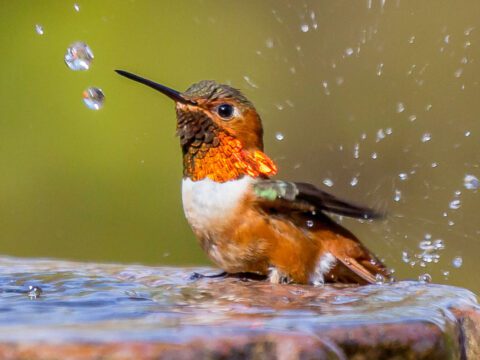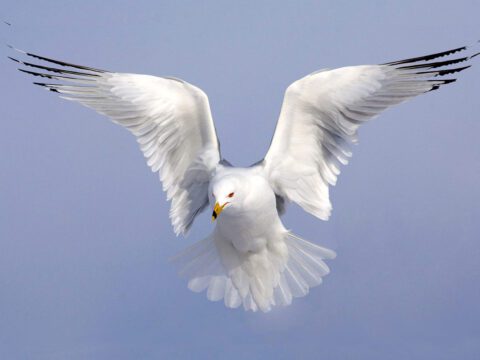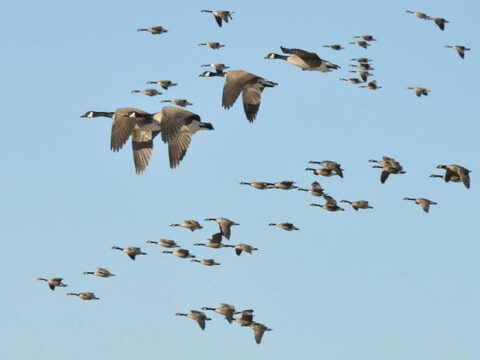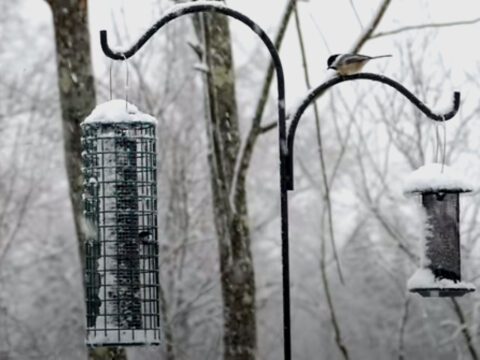Q&A: Olivia Bouler on the Cornell Lab, starfishes, and building a “kid army”
By Hugh Powell July 31, 2012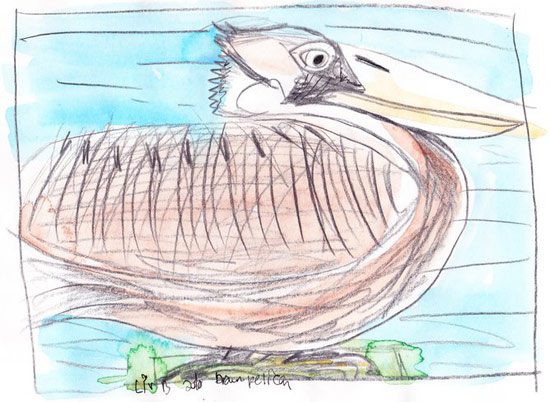
It’s been a little over a year since Olivia Bouler came to visit the Lab and taught an arts workshop for local kids. Olivia made headlines during the Deepwater Horizon oil spill in 2010, when she raised more than $200,000 for wildlife by painting pictures of birds. Since then, she hasn’t looked back, taking her art and her irrepressible personality to tours, exhibitions, schools, and festivals to talk about what’s possible if people—and kids in particular—believe in our ability to change the world.
In May, Olivia, who’s about to enter the eighth grade, was named one of the top 25 most powerful and influential young people (age 5–25) by Youth Service America. The award came with a cash grant, which Olivia donated to the Cornell Lab. Congratulations and thank you, Olivia! Ever since her first letter to Audubon during the Gulf oil spill, she’s been outspoken about her support of the Lab and her desire to attend Cornell someday.
I called her up to say thank you, and got the chance to hear what she’s up to—birds she’s seen recently, her belief in the power of a “kid army” for conservation, and her thoughts on high school now that it’s “just around the corner.” Personally, we can’t wait for her college days to get here.

Thank you for thinking of us—donations play a key part in making the work we do possible. Can you tell me what the award is and what it’s for?
It’s basically a grant, and if you win it you can donate to whatever cause. Cornell is my favorite place in the world, so why wouldn’t I donate it to you?
How did you come to have such a soft spot in your heart for Cornell?
Ever since I was little I kept on hearing, when I read about Audubon, Cornell was always associated with it, and a top ornithology school. I found out it was a college, and that the Lab’s there, and I immediately wanted to go there.
Did your parents get you into bird watching?
Well, my dad is a green architect, but I was the first bird watcher in the family. I was the first real bird nerd.
I always went to the Gulf [of Mexico] when I was little, and my grandmother would always tell me about the pelicans. She would just tell me how they used to be endangered, all this cool stuff about them. And then I wanted to know more so I got this bird book, I think when I was about 4 or 5, and it was all about birds—you know, the Great Auk and how it’s been hunted to extinction…. It sparked my imagination, my creativity, and I absolutely fell in love with birds. And when I realized what I was hearing in my backyard and what I was seeing, the history behind all the birds, something clicked.
Is the Brown Pelican still your favorite bird?
I personally don’t have a favorite bird because that wouldn’t be really fair for the rest of them—I don’t want to offend them or anything [laughs]. But there is a soft spot in my heart for the pelican.
Have you had any cool new sightings recently?
I saw a loon for the first time up in Maine, last weekend. It was absolutely amazing. And I went to Florida a little ways before, and I saw an Eastern Towhee. It was calling in the bush and then it flew out at me, it was pretty awesome.
In Maine you went to Hog Island, right? What were you doing there?
It was a teachers and educators camp. I was speaking to teachers about how in every classroom, they have a kid army, and they just have to teach them the right things and they can spark their own creativity and take action. Because everybody has a talent, no matter how young and no matter how old. Kids want to make a change, it’s just they don’t know how to do it. They don’t think they can make anything, and sometimes parents even put them down on it.
There’s this story about a boy (I forget which beach), but there were tons of starfish that washed up on the beach. And he started tossing them in one at a time, you know, they’re still alive. And there was a man on the beach and he said, “That’s not going to make any change. There’s thousands of starfish on this beach.” And then the boy threw a starfish into the water, and he said, “Well that just made a change to that starfish, didn’t it?”
So sometimes kids, they don’t have reality weighing on their shoulders yet. They just want to do whatever they can, and even if it’s that little boost it still makes a change.
Well that’s a great message—do you still think there’s hope for the environment then?
Definitely, there are new resources, and green opportunities for energy. And I’m not just saying that because my dad is a green architect [laughs].
I remember when you were here last year, you had a Pileated Woodpecker puppet that you were flying around all over the place. Do you still have it?
Oh of course I still have it. I use it for my birding events when I go to schools and stuff. I have this whole array of puppets…. It’s very fun bringing them to schools and pretending like they’re real. And my brother’s like the puppeteer guy and he goes around and makes the noises and everything, and the kids always love it. I say, “This is my friend the Pileated Woodpecker. He lives in such and such an area in this range and he loves to eat insects, and this is how he gets it. And then Jackson does the drumming noise, and then he moves on to, say, a Bald Eagle or a Great Horned Owl or something.
I try to make it as fun as it can be, because i know what it’s like to sit through an assembly that you aren’t really paying attention to because, you know, it’s really far out there. So I try to make it as interactive as possible.
You’re starting eighth grade this fall. Are you excited?
Excited? Yes and no. Pretty much yes. I do like summer because I get to do more birding events and I’m not really on a schedule, I get to sleep in more. You know, with high school on the horizon it’s slightly… it brings the birds in the belly. That’s what I say instead of “butterflies in the stomach.” I like “birds in the belly.”
If you were going to Cornell right now instead of eighth grade, what would you study?
Definitely ornithology. Probably all of it. I’d get a degree, maybe work to rehabilitate birds… I don’t know if my heart could take it if they didn’t make it though.
And what’s this about designing a board game?
Oh yeah, I’m doing a board game and part of the proceeds are going to go to Cornell. My target with my book was to inspire kids and this is another type of thing like that. I’m going to have a puffin from Maine, a Western Bluebird from Arizona, stuff like that. I’m doing a lot of brainstorming. It’s kind of like “Sorry” except a litttle different, with the regions of the U.S. are like the [birds’] homes. You start in one area and it’s like the yearly migration, and the nest is your home, and you’re going back to your mate.
There’s also things like special spaces where you have to draw a card and it could be a good thing or a bad thing. If you answer a question correctly it could help you. Or if you answer it wrong, like say, “What does a Red-tailed Hawk eat?” and if you say, uh, “Flowers,” you move back a couple spaces because one chased you or something. We’re hoping for this Christmas.
And you’re coming here in October to show some of your artwork?
Yes, it’s basically my traveling exhibit, it’s some of the paintings from the book, and some of the newer ones. it’s at Ned Smith Center for Nature and Art right now in Pennsylvania [through September 15], and then it’ll travel to Cornell and who knows where after that?

All About Birds
is a free resource
Available for everyone,
funded by donors like you
American Kestrel by Blair Dudeck / Macaulay Library

